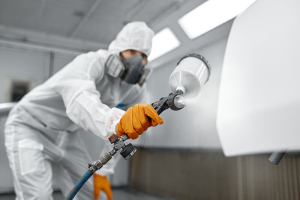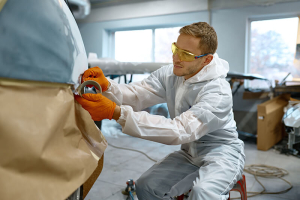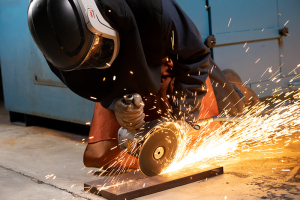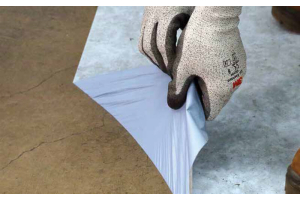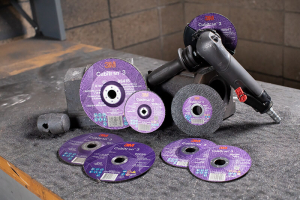Improve Your Composite Sanding With These Tips
Everything You Need To Know About
Sanding Composites
Composite construction materials play a major role in today's manufacturing. Used in everything from transportation and electronics to healthcare, food services and more, it's important that manufacturers are selecting the most cost and resource-efficient methods for composite sanding.
By incorporating a few key strategies and using the best materials for the job, manufacturers can greatly reduce the time and resources needed when working with composite materials.
Here are a few strategies to improve your results:
Composite materials are used in conjunction with other materials in a product, and are sanded and buffed to match the other parts of the structure's smooth, molded finish. Grinding and sanding are the key to getting an even finish. While this process isn't difficult, it can require a lot of product and man hours to complete.
Sanding and grinding plastic composites also generates a lot of heat, which in turn melts the materials and deposits them on the face of the abrasive. This is caused by two things - either the abrasive is dull or the operator began sanding the composite before it was fully cured.
The good news is that there are new abrasives that can greatly reduce loading by using two different methods. Since grinding is usually the first step, consider an abrasive with Performance Coating offered by Arc Abrasives.
They developed their Performance Coating to reduce heat in metal grinding. This is most often occurs with aluminum, which loads quickly. Manufacturing companies are using the coating on fiber discs for heavy composite stock removal. They found it performs well due to the sharp zirconia mineral and the whitish coating applied after the discs are die cut. The resins that usually soften and stick to the surface are shed off, keeping the disc cutting freely and improving the results.
The second option available is the newer multi hole or net dust free sanding discs. These discs help reduce loading by removing the sanding dust before it has a chance to melt and load at the interface. They also are a choice for fine finishes because the 'pilling' usually experienced is eliminated, allowing the abrasive to cut without marring the surface.
Creating The Best Grit Sequence
In order to get that high quality final finish, you need to follow the best grit sequence. Composites cut easily, so go ahead and grind away with 36 grit fiber discs to remove large imperfections. Follow this coarsest step with a random orbital sander and an 80 grit disc to refine scratches before filling with a high build primer.
If you're starting with a gelcoat molded part, use the finest abrasive you can to reduce the chance of cutting through. You can compound gelcoat after sanding with 800 grit, but fine finishes are best achieved by sanding to P800 or P1000 grit, followed by a lamb's wool polishing buff that leaves a brighter shine.
If you're leaving scratches that don't show up until the buffing stage, try using a dye wash between steps. This simple but effective method uses Blue Dye-Chem diluted with either alcohol or acetone and then wiped onto the gelcoat being worked on. The dye flows into the surface profile and you are safe to switch to the next finer grit when all the dye is sanded off. Re-apply for each step and you'll ensure a scratch-free final finish.
Repairing Composite Surfaces
When repairing composite surfaces, the process is similar but there are coatings that require different approaches to achieve a lasting finish.
Gelcoat can be repaired by repairing the area, feathering the repaired surface, and spraying or rolling new gelcoat over the entire feathered area. Follow manufacturer's recommendations for thinning the gelcoat if you intend to spray, as solvents tend to create small pinholes that only appear when you sand it smooth.
Level imperfections in the gelcoat with P400-P600 dust free or wet sand with 30 micron abrasive, followed by P800-P1000 grit or wet 15 micron. Then use 3M Compound and Finishing liquid or Polarshine 35 polishing compound.
For best results, use a lamb's wool or foam pad to reduce the cut and keep pad pressure light and machine speed around 1800 RPM. If your topcoat is a two-part urethane, the process is similar to a gelcoat repair unless your paint is Awlgrip from Akzo Nobel. In that case, you will need to contact us for the procedure that is approved by the manufacturer.
The key differences are in starting grit choices; we don't recommend sanding on urethane paints with anything coarser than P800 grit, and suggest always using water to keep from galling the fresh paint with loaded abrasive.
The Importance Of Grading Systems
One last tip is to remember to check your abrasive to see which system it was graded under. Most modern abrasives use the “P” grading from the Federation of European Abrasive Producers (FEPA), which differs from the older American National Standard Institute (ANSI).
Additionally, several manufacturers sell micron graded abrasives and 3M has Trizact structured abrasives in which the grit size correlates to a roughness average measurement. Refer to the comparison chart below to see how they size up.
It's important to remember that the more modern standards also include a tighter grit size tolerance, so P graded abrasives tend to leave finer, less scratchy surfaces due to fewer ‘rocks' that are allowed into the mix due to looser tolerances.

By implementing a few key strategies and using the right products, manufacturers can deliver high-quality products faster and more cost-effectively. To get more tips and help selecting the right abrasives, contact CW Hayden and speak to a Product Pro.
See Why We're The Top Supplier For Industrial, Marine and Safety
30-Second Summary:
- ✔ Getting a high-quality finish on composite materials requires the right process and the right products.
- ✔ There are two key ways to improve your finish. The first is by using new products by Arc Abrasives with a Performance Coating can help reduce the heat in the grinding process.
- ✔ The second option is to use 3M multi hole or net dust free sanding discs, which reduces loading by removing the sanding dust before it has a chance to melt and load at the interface.
- ✔ It's also important to select the right grit sequence to avoid issues and deliver the best finish for the project.
- ✔ After leveling imperfections in the gelcoat use a compound and finishing liquid after Finally, check each product and see what system it was graded under. Each system uses a different criteria, so make sure you know how fine or coarse each product is before using it.






